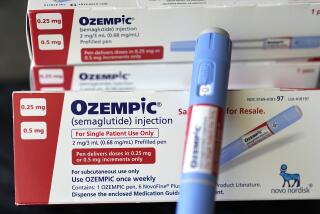Single-dose flu pill wins FDA approval ahead of winter season
- Share via
U.S. approval of the first novel anti-flu pill in two decades has doctors cautiously optimistic about a simpler treatment for a virus that killed almost 200 American children last season.
The drug, which is to be marketed globally by Shionogi & Co. and Roche Holding AG, gained Food and Drug Administration approval just as the winter flu season begins. Developer Shionogi won approval for the treatment, called Xofluza, in Japan in February after studies showed the medication, known also by its chemical name baloxavir, relieved symptoms as quickly as Roche’s Tamiflu with faster antiviral activity.
The tablet gives doctors a new weapon, but studies reveal a tendency for viruses to develop reduced susceptibility to the new treatment. It’s not yet clear whether drug-evading germs are capable of spreading easily between people, causing potency to wane, Roche said. Lab tests indicate that Xofluza also may have weaker activity against the typically less-common influenza B strain.
“A new antiviral against flu is of course welcome and is, at first blush, very attractive because it’s one dose,’’ said William Schaffner, professor of infectious diseases at Vanderbilt University School of Medicine in Nashville. “However, there are a couple of cautions, namely resistance seems to develop fairly readily, and the drug seems not to be as effective against influenza B strains,” he said in a phone interview Tuesday from the Centers for Disease Control and Prevention in Atlanta, where he sits on an immunization practices advisory panel.
The 2017-2018 Northern Hemisphere flu season was especially bad, leading to about 900,000 hospitalizations, including 183 pediatric deaths, in the U.S. alone.
Population-aging and the demand for flu immunizations, treatments and diagnoses will help push up the global influenza market 3% a year to reach $6.5 billion by 2022, BCC Research estimated in April. Shionogi will manufacture the drug in Japan, with the plan to transfer the manufacturing to Basel, Switzerland-based Roche, which has the rights to sell it everywhere except in Japan and Taiwan.
Tamiflu sales fell 33% to $537 million in 2017 after generic versions approved in the U.S. in August 2016 increased competition. Revenue peaked at $3.2 billion in 2009, when a novel H1N1 swine flu virus sparked the first flu pandemic in four decades.
“Xofluza is an excellent drug,” said Atsushi Seki, an analyst with UBS AG in Tokyo. Still, its “commercial potential is moderate,” he said, noting concern among some investors that the potential for drug-resistance represents a risk for sales, as does variation in the severity of flu seasons, which drives prescriptions. The past Southern Hemisphere winter flu season has been relatively mild.
Reduced susceptibility
Patient studies indicated a potential for viruses with reduced susceptibility to Xofluza to emerge in 2.2% to 9.7% of adolescent and adult recipients, and almost 20% of pediatric recipients, according to papers in the New England Journal of Medicine last month. More of the medicine might be needed to stop influenza B, according to a paper published this month in the journal Antiviral Research.
The FDA approved Xofluza to tackle uncomplicated flu in people 12 years and older. It’s the first treatment “to demonstrate a clinically meaningful benefit for people highly vulnerable to serious influenza complications,” Roche said in an Oct. 17 statement. The drug is being tested in a late-stage study of pediatric patients.
It’s taken as a single dose, unlike Tamiflu, which is usually taken twice a day for five days. The simpler regimen both eases concern that poor patient compliance could encourage drug-resistant viruses to emerge, and could ease the medication’s distribution during a pandemic.
These benefits may see Xofluza emerge as the standard of care for uncomplicated flu cases, said Takeki Uehara, who led research and development of the drug at Osaka-based Shionogi. The Japanese drug maker began work on the project in 2007, utilizing a library of molecules screened for activity against a particular vulnerability inherent in flu.
‘Synergistic effect’
Taken together, Xofluza and Tamiflu may have a “synergistic effect” without any adverse interactions, though additional patient studies are needed to confirm a clinical benefit, Uehara said in an interview. Extra research is planned to confirm whether taking Xofluza 10 days before exposure to flu can successfully stave off the respiratory infection.
There is also a plan to test Xofluza in hospitalized patients with influenza in combination with other anti-flu drugs, according to Roche.
Unlike Tamiflu, which works by blocking a protein called neuraminidase that enables newly made viral particles to escape and spread through the respiratory tract, Xofluza targets an enzyme called cap-dependent endonuclease, which is needed to synthesize the proteins used to form new viruses.
“I’m particularly excited about this agent because it’s a novel mechanism in antiviral action,” said Frederick Hayden, a professor of medicine and pathology at the University of Virginia School of Medicine in Charlottesville, who was among a group of researchers studying Xofluza in the U.S. and Japan. “We haven’t had any new influenza drugs in term of how they work in inhibiting the virus in about 20 years.”






